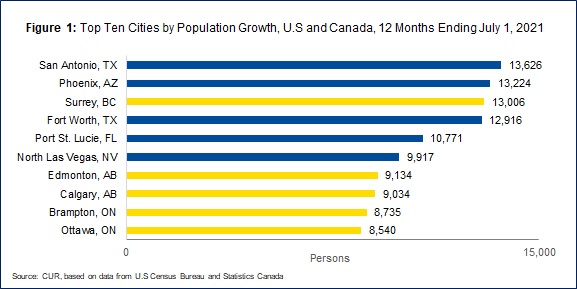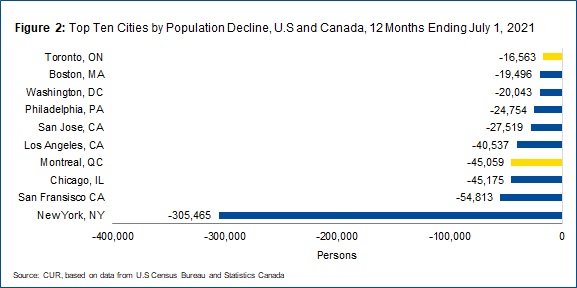Five of the Ten Fastest Growing Cities in the United States/Canada Are Canadian - Montreal and Toronto Join List of Cities with Largest Declines in 2021
By: Frank Clayton with assistance from Ryan Kyle
June 6, 2022
(PDF file) Print-friendly version available
This blog is a follow-up to a recent CUR blog that ranked population growth in 2021 among metropolitan areas in the United States (U.S.) and Canada. This blog compares major cities across the U.S. and Canada. The Bureau of the Census recently released population estimates for cities as of July 1, 2021, comparable to the estimates for Canadian cities that Statistics Canada released earlier in the year.1
This blog compares the growth in population in the 12 months ending July 1, 2021, in larger cities in Canada with those south of the border.2 The data show that five Canadian cities were in the top ten in the U.S. and Canada in terms of numerical growth – Surrey in British Columbia, Edmonton and Calgary in Alberta, and Brampton and Ottawa in Ontario. In contrast, Montreal and Toronto joined the list of ten cities with the most significant population declines.
San Antonio, Phoenix, Surrey and Fort Worth are the four top cities for growth in 2021
Surrey, BC, ranked third across the U.S. and Canada in numerical growth in the twelve months ending July 1, 2021, with 13,006 persons (see Figure 1). Only San Antonio and Phoenix recorded faster absolute growth. These four fastest-growing cities recorded similar increases in population in the 12,916 to 13,626 person range.

Edmonton, Calgary and Ottawa were among the top ten in terms of growth, too. All three were on the top ten list last year, along with Toronto, which recorded a decline in 2021. Brampton joined Surrey as a municipality adjacent to a central city with considerable growth.
Montreal and Toronto join large American cities experiencing population decline
New York City once again was number one in numerical loss of population in 2021, with a decline of 305,465 persons (see Figure 2). San Francisco was second with a population decline of 54,813 persons, followed by Chicago (-45,175) and Montreal (-45,059). Toronto ranked number 10 on the list of declining cities, with a decline of 16,563 persons in 2021.

Toronto’s negative ranking in 2021 is in stark contrast with recent years when it was one of the fastest-growing cities in the U.S. and Canada. A steep drop in immigration and a modestly growing net outflow of the population searching for more affordable ground-related housing (singles, semis and townhouses) were the factors behind Toronto’s population change.
Final Thoughts
Cities with the capacity to accommodate both new ground-related housing (singles, semis and townhouses) and apartments have the most significant potential for growth. A sizable component of future home buyers wants to move into ground-related housing. If they cannot afford to buy in their current municipality, they will move to adjacent cities.
Canadian cities like Toronto, Vancouver and Montreal lack greenfield lands to accommodate the robust demand for ground-related housing. Their growth prospects are less bright than those of Calgary, Edmonton and Ottawa, which have substantial greenfield lands within their boundaries.
Sources:
[1] For Canadian population statistics, see Statistics Canada (2022) Table 17-10-0142-01 Population estimates, July 1, by census subdivision, 2016 boundaries. [Online] Available: https://www150.statcan.gc.ca/t1/tbl1/en/tv.action?pid=1710014201 (external link) . For American population statistics, see U.S. Census, Population Division (2022). ‘Annual Estimates of Resident Population Change for Incorporated Places of 50,000 or More in 2020, Ranked by Percent Change: July 1, 2020, to July 1, 2021.’ [Online] Available: https://www.census.gov/data/tables/time-series/demo/popest/2020s-total-cities-and-towns.html (external link) ; United States Census Bureau Newsroom (2022). ‘2020 Post-Enumeration Survey Results: Fastest Growing Cities Are Still in the West and South.’ [Online] Available: https://www.census.gov/newsroom/press-releases/2022/fastest-growing-cities-population-estimates.html (external link) ; United States Census Bureau Newsroom (2022). ‘Big Population Shifts in Cities and Towns One Year Into Pandemic: New Data Reveal Most Populous Cities Experienced Some of the Largest Decreases.’ [Online] Available: https://www.census.gov/library/stories/2022/05/population-shifts-in-cities-and-towns-one-year-into-pandemic.html (external link) .
[2] This geographical coverage is different from our similar blog released on June 16 last year, which focused on central cities.
Frank Clayton, Ph.D., is Senior Research Fellow at Toronto Metropolitan University’s Centre for Urban Research and Land Development (CUR) in Toronto.
Assistance provided by Ryan Kyle, B.URPl. Research Assistant at Toronto Metropolitan University's Centre for Urban Research and Land Development (CUR) in Toronto.